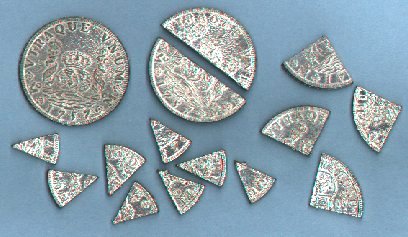 |
| Tredyffrin Easttown Historical Society Home : Tredyffrin History Use the links at left of the article to return. Click on the links below to view the individual articles. | |
Tredyffrin History Digital Archives |
|
Currency |
|
|
Initially the Colonies used British Sterling as the only currency: pounds, shillings and pence (1 pound = 20 shillings, and 1 shilling = 12 pence). One of the problems of using the British currency was that there was a shortage of hard currency in the Colonies. The reason for the lack of currency was there was a balance of payments deficit with Britain, the Colonies buying more goods than they were selling. So money travelled into Britain to pay for these goods. This left a shortage in the Colonies. In response other currencies were substituted for pounds sterling. The most popular seems to have been the Spanish silver dollar (but Portuguese, French and other coins were also circulating). The Spanish silver dollars were often physically cut up, hence pieces of eight. (The image of the pieces of eight below and the other images are of copies of the original coins and notes.) The Portuguese coins were called ‘joes’ and ‘half-joes’; after the Portuguese King Johannes V. The ‘joe’ was worth around £6 Pennsylvania money before the Revolutionary War. |
||||

|
||||
|
There are records of people complaining they had sold some goods and had been paid in a combination of 6 currencies! It is also said that when you went into a store in the Colonies the first thing the shopkeeper would ask was how you were going to pay. The reason for the question was that the price depended on what type of currency, barter, or credit you were going to use. To relieve the situation the Colonies issued their own paper currency in pounds, shillings, and pence (old currency). Pennsylvania first issued paper currency in 1723. Unfortunately the value of these currencies varied both from the pound Sterling and between the Colonies. |
||||
|
||||
|
With the outbreak of the Revolutionary War the Continental Congress issued its own Continental Money in the British units, but it rapidly depreciated. This depreciation was accelerated by the British flooding the market with counterfeit notes. The Colonies and Congress also issued notes in Spanish dollars. The American dollar was not created until 1785 and it took a few years after that before it was in common circulation. |
||||
|
||||